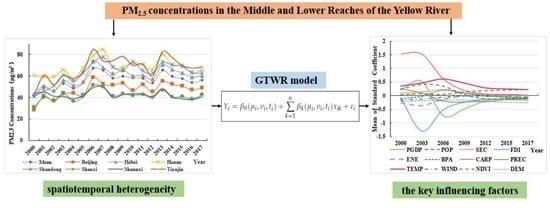Identifying Spatiotemporal Heterogeneity of PM2.5 Concentrations and the Key Influencing Factors in the Middle and Lower Reaches of the Yellow River
Abstract
:1. Introduction
2. Material and Data Sources
2.1. Study Area
2.2. Data Sources and Preprocessing
2.2.1. PM2.5 Concentrations Data
2.2.2. Socio-Economic Data
2.2.3. Natural Conditions Data
3. Methodology
3.1. Spatial Autocorrelation Models
3.1.1. Global Spatial Autocorrelation Analysis
3.1.2. Local Spatial Autocorrelation Analysis
3.1.3. Geographically and Temporally Weighted Regression Model
4. Results and Discussion
4.1. Temporal Variation Characteristics of PM2.5 Concentrations
4.2. Spatial Distribution Characteristics of PM2.5 Concentrations
4.3. Spatial Autocorrelation Analysis of PM2.5 Concentrations
4.3.1. Global Spatial Autocorrelation Features
4.3.2. Local Spatial Autocorrelation Features
4.4. Determination of the Best Model
4.5. The Temporal and Spatial Variation in the Standard Coefficients of Explanatory Variables in GTWR Model
4.5.1. Influence of Independent Variables on PM2.5 Concentrations on a Global Perspective
4.5.2. Spatial Heterogeneity Characteristics of Regression Coefficients
4.6. Policy Implications
5. Conclusions
- (1)
- The annual average PM2.5 concentrations in the middle and lower reaches of the Yellow River showed a trend of increasing first and then decreasing from 2000 to 2017, and the annual average PM2.5 concentrations are higher than 100 µg/m3 appeared in 2006, 2007 and 2013, respectively. Overall, the PM2.5 pollution was still very serious. The pollution degree of PM2.5 concentrations was an obvious difference among five provinces and two municipalities. The PM2.5 concentrations of Tianjin, Shandong Province, and Henan Province were far higher than the overall mean value of the study area, while Shaanxi Province decreased in a fluctuation way from 42.12 µg/m3 (2000) to 36.69 µg/m3 (2017);
- (2)
- From the spatial distribution characteristics of PM2.5 concentrations, the annual average of PM2.5 in western cities showed a declining trend, while it had a gradually rising trend in the middle and eastern cities of the study area. Meanwhile, the PM2.5 pollution showed the characteristics of path dependence and region locking. Cities with high PM2.5 values are always located in northern Henan Province, western Shandong Province, and southern Hebei Province;
- (3)
- All the global Moran’s I indexes were >0.6, indicating that the PM2.5 concentrations had significant spatial agglomeration characteristics in the study area. In addition, the PM2.5 concentrations had an obvious local spatial autocorrelation feature. The H-H clusters were mainly concentrated in the southern Hebei Province and the northern Henan Province, and the L-L clusters were concentrated in northwest marginal cities in the study area;
- (4)
- The influencing factors of PM2.5 have significant temporal and spatial non-stationary characteristics, and there are obvious differences in the direction and intensity of socio-economic and natural factors. Overall, car ownership and population density are the main socio-economic driving factors that have positive effects on PM2.5, while FDI plays a strong negative effect on PM2.5. Temperature is one of the most important natural conditions to play a positive impact on PM2.5, while DEM makes a strong negative impact on PM2.5. In addition, each influencing factor has positive and negative effects on different regional PM2.5, and these factors have spatial instability characteristics.
Author Contributions
Funding
Data Availability Statement
Conflicts of Interest
References
- Ji, G.; Tian, L.; Zhao, J.; Yue, Y.; Wang, Z. Detecting spatiotemporal dynamics of PM 2.5 emission data in China using DMSP-OLS nighttime stable light data. J. Clean. Prod. 2018, 209, 363–370. [Google Scholar] [CrossRef]
- Li, S.; Yang, L.; Chen, L.; Zhao, F.; Sun, L. Spatial distribution of heavy metal concentrations in peri-urban soils in eastern China. Environ. Sci. Pollut. Res. Int. 2018, 26, 1615–1627. [Google Scholar] [CrossRef]
- Guo, B.; Wang, Y.; Pei, L.; Yu, Y.; Liu, F.; Zhang, D.; Wang, X.; Su, Y.; Zhang, D.; Zhang, B.; et al. Determining the effects of socioeconomic and environmental determinants on chronic obstructive pulmonary disease (COPD) mortality using geographically and temporally weighted regression model across Xi’an during 2014–2016. Sci. Total Environ. 2021, 756, 143869. [Google Scholar] [CrossRef] [PubMed]
- Delfino, R.J.; Sioutas, C.; Malik, S. Potential Role of Ultrafine Particles in Associations between Airborne Particle Mass and Cardiovascular Health. Environ. Health Persp. 2005, 11, 934–946. [Google Scholar] [CrossRef] [Green Version]
- Peng, J.; Chen, S.; Lü, H.; Liu, Y.; Wu, J. Spatiotemporal patterns of remotelysensed PM2.5 concentrations in China from 1999 to 2011. Remote Sens. Environ. 2016, 174, 109–121. [Google Scholar] [CrossRef]
- Lim, S.S.; Vos, T.; Flaxman, A.D.; Danaei, G.; Shibuya, K.; Adair-Rohani, H.; Amann, M.; Anderson, H.R.; Andrews, K.G.; Aryee, M.; et al. A comparative risk assessment of burden of disease and injury attributable to 67 risk factors and risk factor clusters in 21 regions, 1990–2010: A systematic analysis for the Global Burden of Disease Study 2010. Lancet 2012, 380, 2224–2260. [Google Scholar] [CrossRef] [Green Version]
- Zeng, Y.; Cao, Y.; Qiao, X.; Seyler, B.C.; Tang, Y. Air pollution reduction in China: Recent success but great challenge for the future. Sci. Total Environ. 2019, 663, 329–337. [Google Scholar] [CrossRef]
- CPGPRC. A Circular on “Action Plan on Prevention and Control of Air Pollution”Issued by the the State Council in China. t.S.C.o. Available online: http://www.gov.cn/zwgk/2013-09/12/content_2486773.htm (accessed on 20 April 2022).
- Jiang, W.; Gao, W.; Gao, X.; Ma, M.; Zhou, M.; Du, K.; Ma, X. Spatio-temporal heterogeneity of air pollution and its key influencing factors in the Yellow River Economic Belt of China from 2014 to 2019. J. Environ. Manage. 2021, 296, 113172. [Google Scholar] [CrossRef]
- Mi, Y.; Sun, K.; Li, L.; Lei, Y.; Yang, J. Spatiotemporal pattern analysis of PM2.5 and the driving factors in the Middle Yellow River Urban Agglomerations. J. Clean. Prod. 2021, 29, 126904. [Google Scholar] [CrossRef]
- Kloog, I.; Nordio, F.; Coull, B.A.; Schwartz, J. Incorporating Local Land Use Regression And Satellite Aerosol Optical Depth In A Hybrid Model Of Spatiotemporal PM2.5 Exposures In The Mid-Atlantic States. Environ. Sci. Technol. 2012, 46, 11913. [Google Scholar] [CrossRef] [Green Version]
- Ma, X.; Jia, H.; Sha, T.; An, J.; Tian, R. Spatial and seasonal characteristics of particulate matter and gaseous pollution in China: Implications for control policy. Environ. Pollut. 2019, 248, 421–428. [Google Scholar] [CrossRef] [PubMed]
- Zhang, L.; An, J.; Liu, M.; Li, Z.; Luo, Y. Spatiotemporal variations and influencing factors of PM2.5 concentrations in Beijing, China. Environ. Pollut. 2020, 262, 114276. [Google Scholar] [CrossRef]
- Querol, X.; Alastuey, A.; Ruiz, C.R.; Arti Ano, B.; Hansson, H.C.; Harrison, R.M.; Buringh, E.; Brink, H.; Lutz, M.; Bruckmann, P. Speciation and origin of PM10 and PM2.5 in selected European cities. Atmos. Environ. 2004, 38, 6547–6555. [Google Scholar] [CrossRef]
- Liang, Z.; Zhou, C.; Fan, Y.; Lei, C.; Sun, D. Spatio-temporal evolution and the influencing factors of PM2.5 in China between 2000 and 2015. J. Geogr. Sci. 2019, 29, 253–270. [Google Scholar]
- Wang, Y.; Duan, X.; Wang, L. Spatial-Temporal Evolution of PM2.5 Concentration and its Socioeconomic Influence Factors in Chinese Cities in 2014–2017. Int. J. Environ. Res. Public Health 2019, 16, 985. [Google Scholar] [CrossRef] [PubMed] [Green Version]
- Ye, W.F.; Ma, Z.Y.; Ha, X.Z.; Yang, H.C.; Weng, Z.X. Spatiotemporal patterns and spatial clustering characteristics of air quality in China: A city level analysis. Ecol. Indic. 2018, 91, 523–530. [Google Scholar] [CrossRef]
- Fang, X.; Fan, Q.; Liao, Z.; Xie, J.; Xu, X.; Fan, S. Spatial-temporal characteristics of the air quality in the GuangdongHong KongMacau Greater Bay Area of China during 2015–2017. Atmos. Environ. 2019, 210, 14–34. [Google Scholar] [CrossRef]
- Van Donkelaar, A.; Martin, R.V.; Brauer, M.; Boys, B.L. Use of Satellite Observations for Long-Term Exposure Assessment of Global Concentrations of Fine Particulate Matter. Environ. Health Persp. 2015, 123, 135–143. [Google Scholar] [CrossRef] [Green Version]
- Heimann, I.; Bright, V.B.; Mcleod, M.W.; Mead, M.I.; Popoola, O.; Stewart, G.B.; Jones, R.L. Source attribution of air pollution by spatial scale separation using high spatial density networks of low cost air quality sensors. Atmos. Environ. 2015, 113, 10–19. [Google Scholar] [CrossRef] [Green Version]
- Xu, J.; Jia, C.; Yu, H.; Xu, H.; Ji, D.; Wang, C.; Xiao, H.; He, J. Characteristics, sources, and health risks of PM2.5-bound trace elements in representative areas of Northern Zhejiang Province, China. Chemosphere 2021, 272, 129632. [Google Scholar] [CrossRef]
- Chang, Z.; Deng, C.; Long, F.; Zheng, L. High-speed rail, firm agglomeration, and PM2.5: Evidence from China. Transp. Res. Part D Transp. Environ. 2021, 96, 102886. [Google Scholar] [CrossRef]
- Gummeneni, S.; Yusup, Y.B.; Chavali, M.; Samadi, S.Z. Source apportionment of particulate matter in the ambient air of Hyderabad city, India. Atmos. Res. 2011, 101, 752–764. [Google Scholar] [CrossRef]
- Han, L.; Zhou, W.; Li, W.; Li, L. Impact of urbanization level on urban air quality: A case of fine particles (PM2.5) in Chinese cities. Environ. Pollut. 2014, 194, 163–170. [Google Scholar] [CrossRef] [PubMed]
- Poon, J.P.H.; Casas, I.; He, C. The Impact of Energy, Transport, and Trade on Air Pollution in China. Eurasian Geogr. Econ. 2006, 5, 568–584. [Google Scholar] [CrossRef]
- Liu, X.J.; Xia, S.Y.; Yang, Y.; Wu, J.F.; Ren, Y.W. Spatiotemporal dynamics and impacts of socioeconomic and natural conditions on PM2.5 in the Yangtze River Economic Belt. Environ. Pollut. 2020, 263, 114569. [Google Scholar] [CrossRef] [PubMed]
- Wang, Z.; Fang, C. Spatial-temporal characteristics and determinants of PM 2.5 in the Bohai Rim Urban Agglomeration. Chemosphere 2016, 148, 148–162. [Google Scholar] [CrossRef] [PubMed]
- Tao, M.; Chen, L.; Xiong, X.; Zhang, M.; Ma, P.; Tao, J.; Wang, Z. Formation process of the widespread extreme haze pollution over northern China in January 2013: Implications for regional air quality and climate. Atmos. Environ. 2014, 98, 417–425. [Google Scholar] [CrossRef]
- Pant, P.; Shukla, A.; Kohl, S.D.; Chow, J.C.; Harrison, R.M. Characterization of ambient PM 2.5 at a pollution hotspot in New Delhi, India and inference of sources. Atmos. Environ. 2015, 109, 178–189. [Google Scholar] [CrossRef]
- Li, G.; Fang, C.; Wang, S.; Sun, S. The Effect of Economic Growth, Urbanization, and Industrialization on Fine Particulate Matter (PM2.5) Concentrations in China. Environ. Sci. Technol. 2016, 50, 11452–11459. [Google Scholar] [CrossRef]
- Wang, X.; Tian, G.; Yang, D.; Zhang, W.; Lu, D.; Liu, Z. Responses of PM2.5 pollution to urbanization in China. Energ. Policy 2018, 123, 602–610. [Google Scholar] [CrossRef]
- Chang, F.; Chang, L.; Kang, C.; Wang, Y.; Huang, A. Explore spatio-temporal PM2.5 features in northern Taiwan using machine learning techniques. Sci. Total Environ. 2020, 736, 139656. [Google Scholar] [CrossRef] [PubMed]
- Nowak, D.J.; Hirabayashi, S.; Bodine, A.; Greenfield, E. Tree and forest effects on air quality and human health in the United States. Environ. Pollut. 2014, 193, 119–129. [Google Scholar] [CrossRef] [PubMed] [Green Version]
- Timmermans, R.; Kranenburg, R.; Manders, A.; Hendriks, C.; Segers, A.; Dammers, E.; Zhang, Q.; Wang, L.; Liu, Z.; Zeng, L.; et al. Source apportionment of PM2.5 across China using LOTOS-EUROS. Atmos. Environ. 2017, 164, 370–386. [Google Scholar] [CrossRef]
- Zhou, C.; Chen, J.; Wang, S. Examining the effects of socioeconomic development on fine particulate matter (PM2.5) in China’s cities using spatial regression and the geographical detector technique. Sci. Total Environ. 2018, 619, 436–445. [Google Scholar] [CrossRef]
- Thongthammachart, T.; Jinsart, W. Estimating PM 2.5 concentrations with statistical distribution techniques for health risk assessment in Bangkok. Hum. Ecol. Risk Assess. 2019, 26, 1843–1868. [Google Scholar]
- Ma, Z.; Hu, X.; Sayer, A.M.; Levy, R.; Liu, Y. Satellite-Based Spatiotemporal Trends in PM2.5 Concentrations: China, 2004–2013. Environ. Health Perspect. 2016, 124, 184–192. [Google Scholar] [CrossRef] [Green Version]
- Xie, Y.; Wang, Y.; Zhang, K.; Dong, W.; Lv, B.; Bai, Y. Daily estimation of ground-level PM2.5 concentrations over Beijing using 3 km resolution MODIS AOD. Environ. Sci. Technol. 2015, 49, 12280–12288. [Google Scholar] [CrossRef] [Green Version]
- Xu, B.; Luo, L.; Lin, B. A dynamic analysis of air pollution emissions in China: Evidence from nonparametric additive regression models. Ecol. Indic. 2016, 63, 346–358. [Google Scholar] [CrossRef]
- Cheng, Z. The spatial correlation and interaction between manufacturing agglomeration and environmental pollution. Ecol. Indic. 2016, 61, 1024–1032. [Google Scholar] [CrossRef]
- Zhang, W.W.; Sharp, B.; Xu, S.C. Does economic growth and energy consumption drive environmental degradation in China’s 31 provinces? New evidence from a spatial econometric perspective. Appl. Econ. 2019, 51, 4658–4671. [Google Scholar] [CrossRef]
- Liu, X.; Li, L.; Ge, J.; Tang, D.; Zhao, S. Spatial Spillover Effects of Environmental Regulations on China’s Haze Pollution Based on Static and Dynamic Spatial Panel Data Models. Pol. J. Environ. Stud. 2019, 28, 2231–2241. [Google Scholar] [CrossRef]
- Liao, S.; Wang, D.; Liang, Z.; Xia, C.; Zhao, W. Spatial Spillover Effect and Sources of City-Level Haze Pollution in China: A Case Study of Guangdong Provinces. Pol. J. Environ. Stud. 2020, 29, 3213–3223. [Google Scholar] [CrossRef]
- Wang, J.; Wang, S.; Li, S. Examining the spatially varying effects of factors on PM_(2.5) concentrations in Chinese cities using geographically weighted regression modeling. Environ. Pollut. 2019, 248, 792–803. [Google Scholar] [CrossRef] [PubMed]
- Sun, X.; Luo, X.; Xu, J.; Zhao, Z.; Chen, Y.; Wu, L.; Chen, Q.; Zhang, D. Spatio-temporal variations and factors of a provincial PM2.5 pollution in eastern China during 2013-2017 by geostatistics. Sci. Rep. 2019, 9, 3613–3622. [Google Scholar] [CrossRef] [Green Version]
- Li, R.; Wang, Z.; Cui, L.; Fu, H.; Zhang, L.; Kong, L.; Chen, W.; Chen, J. Air pollution characteristics in China during 2015–2016: Spatiotemporal variations and key meteorological factors. Sci. Total Environ. 2018, 648, 902–915. [Google Scholar] [CrossRef]
- Huang, B.; Wu, B.; Barry, M. Geographically and temporally weighted regression for modeling spatio-temporal variation in house prices. Int. J. Geogr. Inf. Sci. 2010, 24, 383–401. [Google Scholar] [CrossRef]
- Bai, Y.; Wu, L.; Qin, K.; Zhang, Y.; Shen, Y.; Zhou, Y. A Geographically and Temporally Weighted Regression Model for Ground-Level PM2.5 Estimation from Satellite-Derived 500 m Resolution AOD. Remote Sens. 2016, 8, 262. [Google Scholar] [CrossRef] [Green Version]
- Chen, Y.; Tian, W.; Zhou, Q.; Shi, T. Spatiotemporal and Driving Forces of Ecological Carrying Capacity for High-Quality Development of 286 Cities in China. J. Clean. Prod. 2021, 293, 126186. [Google Scholar] [CrossRef]
- Fotheringham, A.S.; Crespo, R.; Yao, J. Geographical and Temporal Weighted Regression (GTWR). Geogr. Anal. 2015, 47, 431–452. [Google Scholar] [CrossRef] [Green Version]
- Van Donkelaar, A.; Martin, R.V.; Brauer, M.; Hsu, N.C.; Kahn, R.A.; Levy, R.C. Global Estimates of Fine Particulate Matter using a Combined Geophysical-Statistical Method with Information from Satellites, Models, and Monitors. Environ. Sci. Technol. 2016, 50, 3762–3772. [Google Scholar] [CrossRef]
- Mcguinn, L.A.; Ward-Caviness, C.; Neas, L.M.; Schneider, A.; Qian, D.; Chudnovsky, A.; Schwartz, J.; Koutrakis, P.; Russell, A.G.; Garcia, V. Fine Particulate Matter and Cardiovascular Disease: Comparison of Assessment Methods for Long-term Exposure. Environ. Res. 2017, 159, 16–23. [Google Scholar] [CrossRef] [PubMed]
- Lu, D.; Xu, J.; Yang, D.; Zhao, J. Spatio-temporal variation and influence factors of PM2.5 concentrations in China from 1998 to 2014. Atmos. Pollut. Res. 2017, 8, 1151–1159. [Google Scholar] [CrossRef]
- Luo, Y.; Deng, Q.F.; Yang, K.; Yang, Y.; Shang, C.X.; Yu, Z.Y. Spatial-Temporal Change Evolution of PM2.5 in Typical Regions of China in Recent 20 Years. Environ. Sci. 2018, 39, 3003–3013. [Google Scholar]
- Yang, J.; Ren, J.Y.; Sun, D.Q.; Xiao, X.M.; Xia, J.H.; Jin, C.; Li, X.M. Understanding land surface temperature impact factors based on local climate zones. Sustain. Cities Soc. 2021, 69, 102818. [Google Scholar] [CrossRef]
- Yang, K.; Jie, H.; Tang, W.; Qin, J.; Cheng, C. On downward shortwave and longwave radiations over high altitude regions: Observation and modeling in the Tibetan Plateau. Agric. For. Meteorol. 2010, 150, 38–46. [Google Scholar] [CrossRef]
- He, J.; Yang, K.; Tang, W.; Lu, H.; Qin, J.; Chen, Y.; Li, X. The first high-resolution meteorological forcing dataset for land process studies over China. Sci. Data 2020, 7, 25–35. [Google Scholar] [CrossRef] [Green Version]
- Anselin, L. Specification tests on the structure of interaction in spatial econometric models. Pap. Reg. Sci. 1984, 54, 165–182. [Google Scholar] [CrossRef]
- Anselin, L. Local indicator of spatial association-lisa. Geogr. Anal. 1995, 27, 91–115. [Google Scholar] [CrossRef]
- Lu, B.; Harris, P.; Charlton, M.; Brunsdon, C. Calibrating a Geographically Weighted Regression Model with Parameter-specific Distance Metrics. Procedia Environ. Sci. 2015, 26, 109–114. [Google Scholar] [CrossRef] [Green Version]



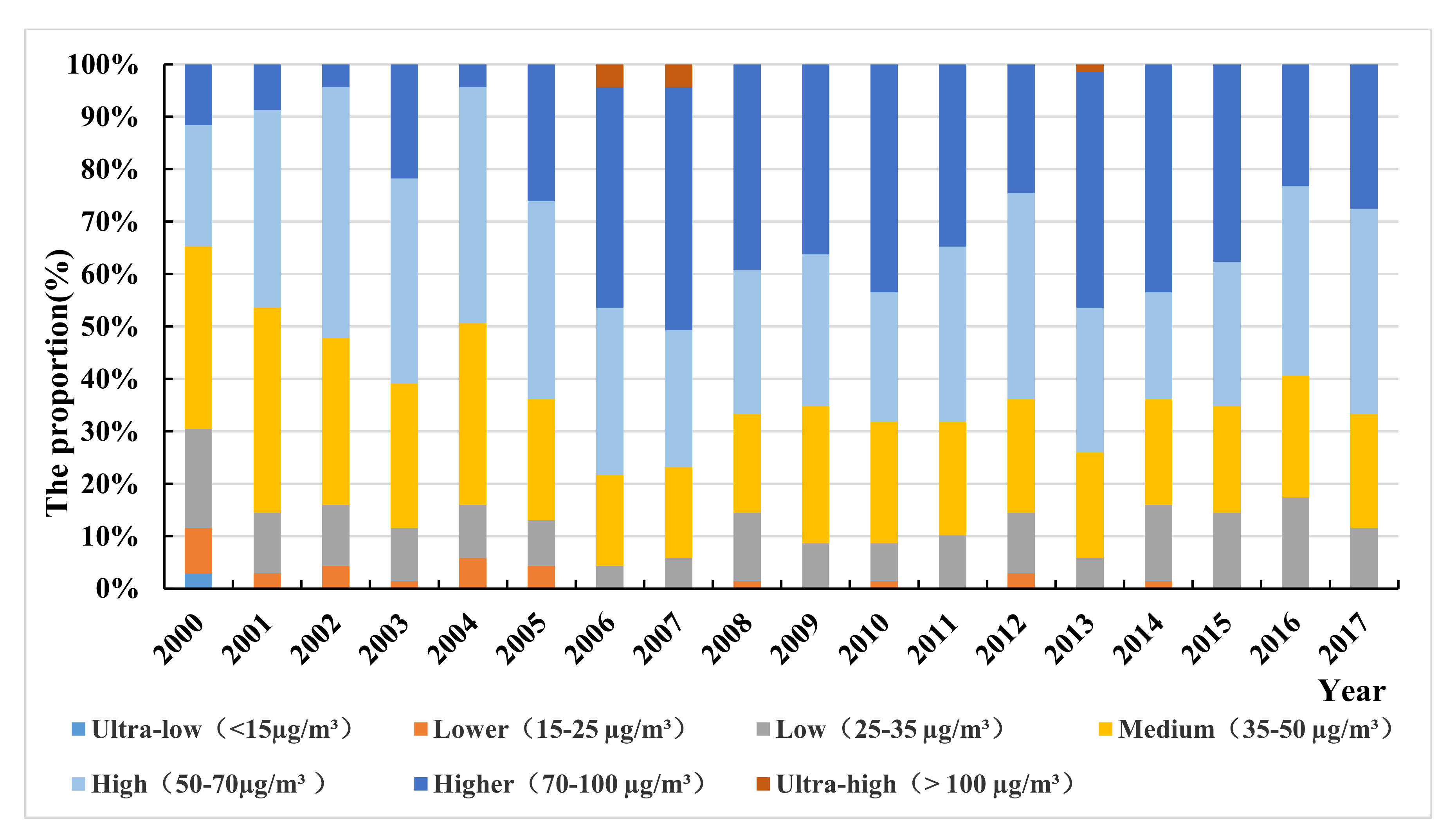
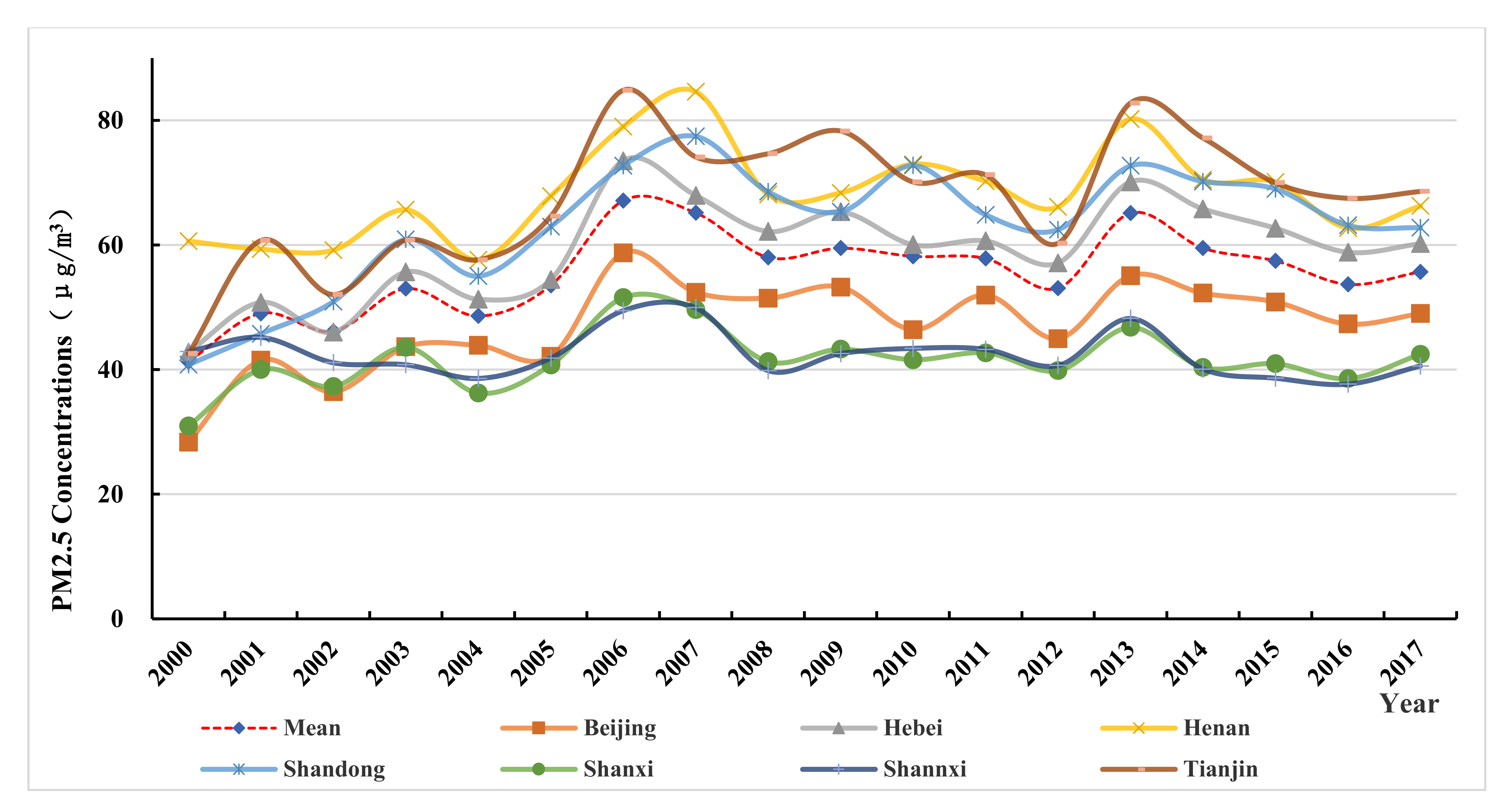


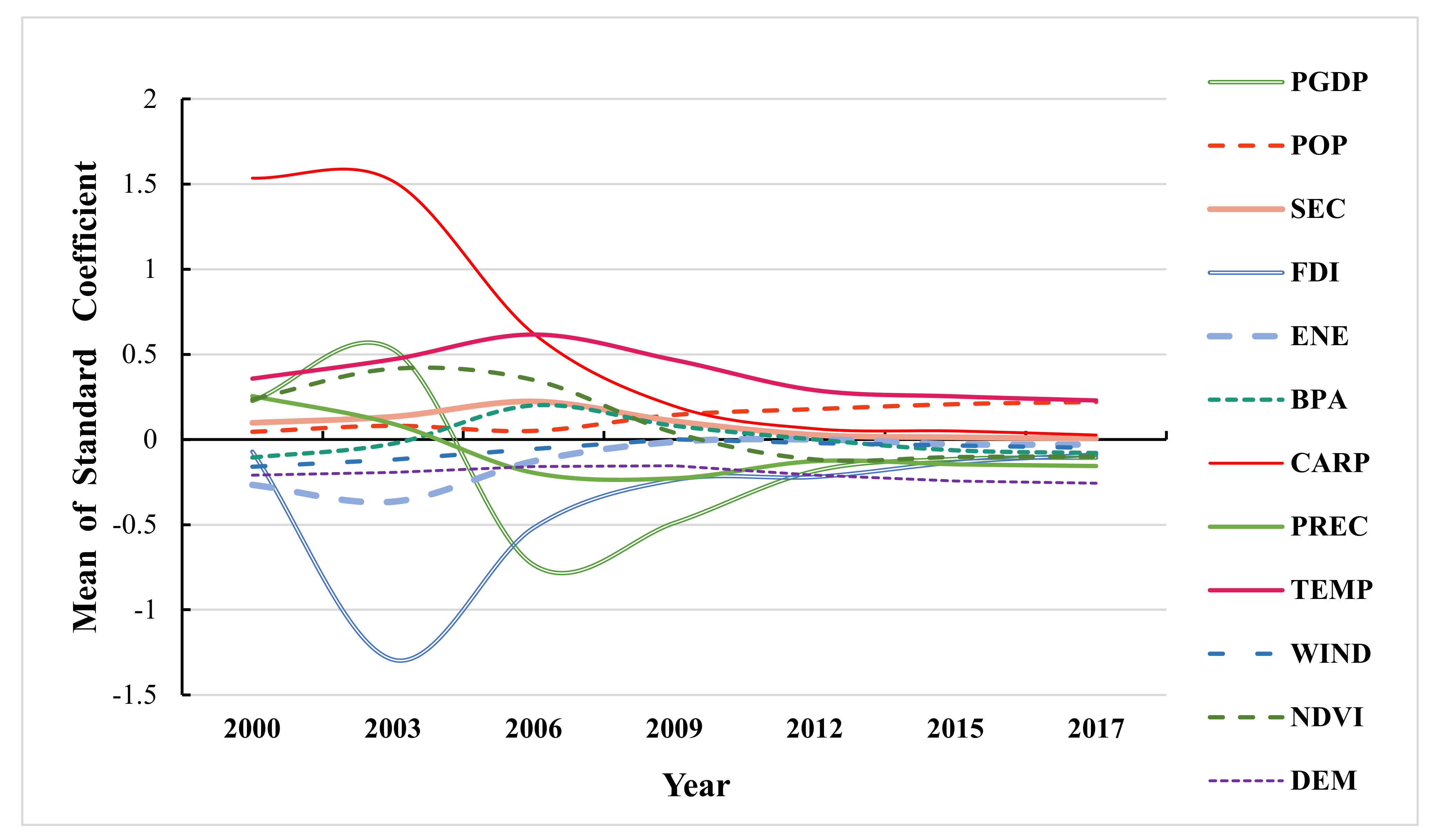
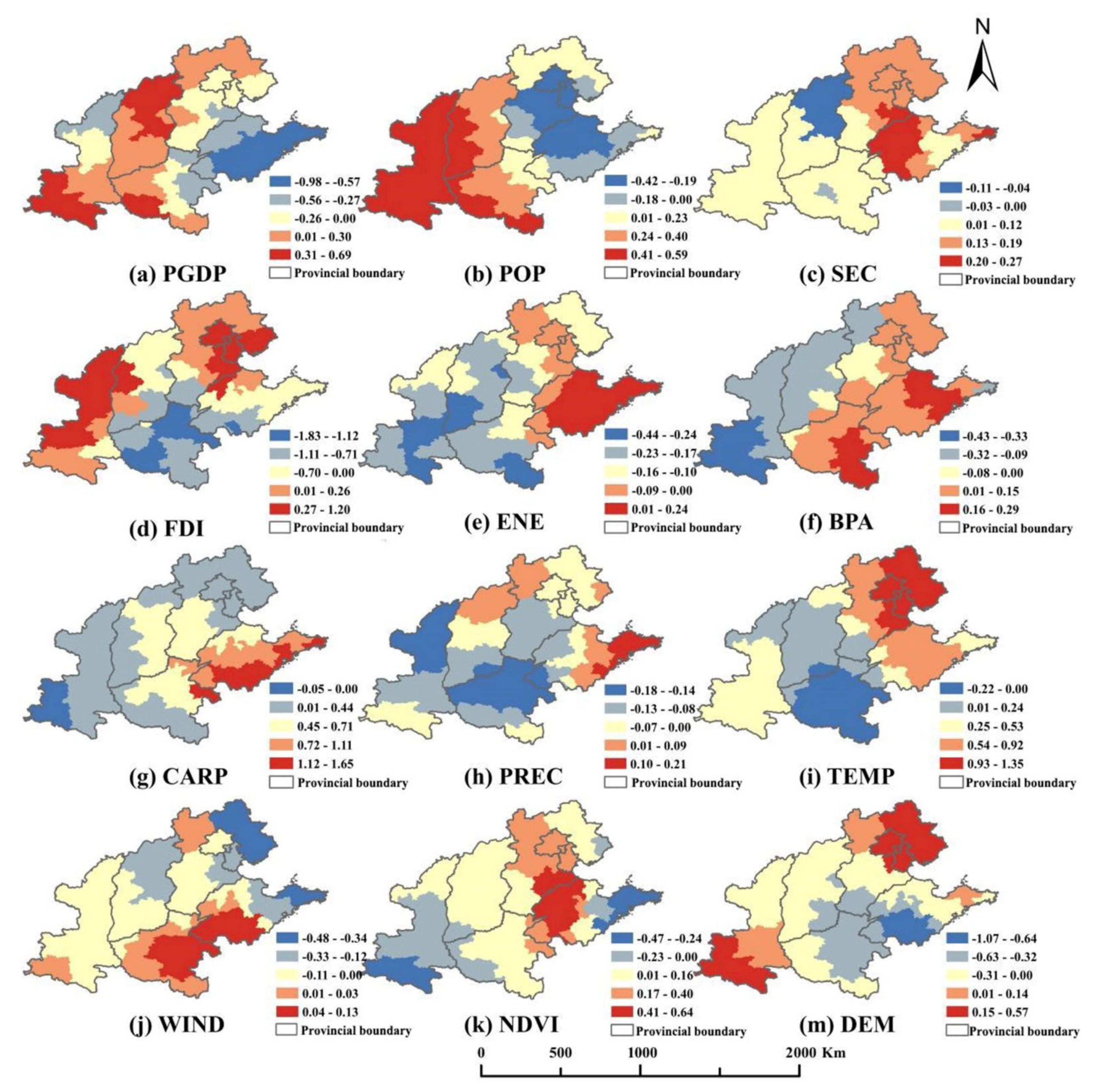
| Year | 2000 | 2003 | 2006 | 2009 | 2012 | 2015 | 2017 |
|---|---|---|---|---|---|---|---|
| Average of the whole study area | 41.28 | 53.00 | 67.12 | 59.48 | 53.06 | 57.45 | 55.69 |
| Beijing Municipality | 28.37 | 43.66 | 58.73 | 53.25 | 44.97 | 50.85 | 48.98 |
| Hebei Province | 42.81 | 55.66 | 73.52 | 65.32 | 57.11 | 62.69 | 60.21 |
| Henan Province | 60.60 | 65.65 | 78.99 | 68.35 | 66.12 | 70.10 | 66.26 |
| Shandong Province | 40.78 | 60.88 | 72.75 | 65.34 | 62.45 | 68.99 | 62.77 |
| Shanxi Province | 30.94 | 43.57 | 51.54 | 43.27 | 39.84 | 40.94 | 42.45 |
| Shannxi Province | 42.90 | 40.77 | 49.46 | 42.57 | 40.66 | 38.62 | 40.59 |
| Tianjin Municipality | 42.54 | 60.78 | 84.83 | 78.29 | 60.28 | 69.97 | 68.59 |
| Year | Moran’s I | Z-Score | p-Value | Year | Moran’s I | Z-Score | p-Value |
|---|---|---|---|---|---|---|---|
| 2000 | 0.71 | 8.61 | 0.00 | 2009 | 0.71 | 8.55 | 0.00 |
| 2001 | 0.63 | 7.62 | 0.00 | 2010 | 0.76 | 9.12 | 0.00 |
| 2002 | 0.63 | 7.63 | 0.00 | 2011 | 0.70 | 8.38 | 0.00 |
| 2003 | 0.68 | 8.17 | 0.00 | 2012 | 0.73 | 8.77 | 0.00 |
| 2004 | 0.65 | 7.90 | 0.00 | 2013 | 0.72 | 8.64 | 0.00 |
| 2005 | 0.71 | 8.55 | 0.00 | 2014 | 0.74 | 8.85 | 0.00 |
| 2006 | 0.67 | 8.14 | 0.00 | 2015 | 0.75 | 8.99 | 0.00 |
| 2007 | 0.73 | 8.80 | 0.00 | 2016 | 0.71 | 8.57 | 0.00 |
| 2008 | 0.72 | 8.69 | 0.00 | 2017 | 0.72 | 8.61 | 0.00 |
| Types | Number of Cities (Units) | ||||||
|---|---|---|---|---|---|---|---|
| 2000 | 2003 | 2006 | 2009 | 2012 | 2015 | 2017 | |
| HH | 14 | 13 | 11 | 8 | 12 | 12 | 10 |
| LL | 5 | 3 | 4 | 4 | 4 | 3 | 4 |
| Model | R2 | R2-Adjusted | AICc | Residual Squares |
|---|---|---|---|---|
| OLS | 0.692246 | 0.684388 | −753.33726 | 5.5991 |
| TWR | 0.803587 | 0.798573 | −881.816 | 3.58083 |
| GWR | 0.878789 | 0.875694 | −997.256 | 2.20983 |
| GTWR | 0.953621 | 0.952437 | −1149.7 | 0.845549 |
| Mean | Min | Max | Std | |
|---|---|---|---|---|
| Intercept | 0.160 | −1.441 | 0.886 | 0.506 |
| PGDP | −0.125 | −2.459 | 2.970 | 0.772 |
| POP | 0.132 | −0.933 | 0.821 | 0.378 |
| SEC | 0.087 | −0.266 | 0.531 | 0.135 |
| FDI | −0.366 | −5.180 | 5.496 | 1.106 |
| ENE | −0.119 | −1.220 | 0.628 | 0.281 |
| BPA | 0.001 | −0.972 | 0.724 | 0.288 |
| CARP | 0.573 | −1.032 | 5.125 | 0.899 |
| PREC | −0.072 | −0.397 | 0.663 | 0.214 |
| TEMP | 0.383 | −0.543 | 2.384 | 0.462 |
| WIND | −0.063 | −0.700 | 0.306 | 0.151 |
| NDVI | 0.103 | −0.815 | 1.467 | 0.410 |
| DEM | −0.204 | −1.867 | 1.398 | 0.368 |
| Residual | 0.005 | −0.151 | 0.203 | 0.042 |
| R2 | 0.954 |
Publisher’s Note: MDPI stays neutral with regard to jurisdictional claims in published maps and institutional affiliations. |
© 2022 by the authors. Licensee MDPI, Basel, Switzerland. This article is an open access article distributed under the terms and conditions of the Creative Commons Attribution (CC BY) license (https://creativecommons.org/licenses/by/4.0/).
Share and Cite
Zhao, H.; Liu, Y.; Gu, T.; Zheng, H.; Wang, Z.; Yang, D. Identifying Spatiotemporal Heterogeneity of PM2.5 Concentrations and the Key Influencing Factors in the Middle and Lower Reaches of the Yellow River. Remote Sens. 2022, 14, 2643. https://doi.org/10.3390/rs14112643
Zhao H, Liu Y, Gu T, Zheng H, Wang Z, Yang D. Identifying Spatiotemporal Heterogeneity of PM2.5 Concentrations and the Key Influencing Factors in the Middle and Lower Reaches of the Yellow River. Remote Sensing. 2022; 14(11):2643. https://doi.org/10.3390/rs14112643
Chicago/Turabian StyleZhao, Hongbo, Yaxin Liu, Tianshun Gu, Hui Zheng, Zheye Wang, and Dongyang Yang. 2022. "Identifying Spatiotemporal Heterogeneity of PM2.5 Concentrations and the Key Influencing Factors in the Middle and Lower Reaches of the Yellow River" Remote Sensing 14, no. 11: 2643. https://doi.org/10.3390/rs14112643
APA StyleZhao, H., Liu, Y., Gu, T., Zheng, H., Wang, Z., & Yang, D. (2022). Identifying Spatiotemporal Heterogeneity of PM2.5 Concentrations and the Key Influencing Factors in the Middle and Lower Reaches of the Yellow River. Remote Sensing, 14(11), 2643. https://doi.org/10.3390/rs14112643





